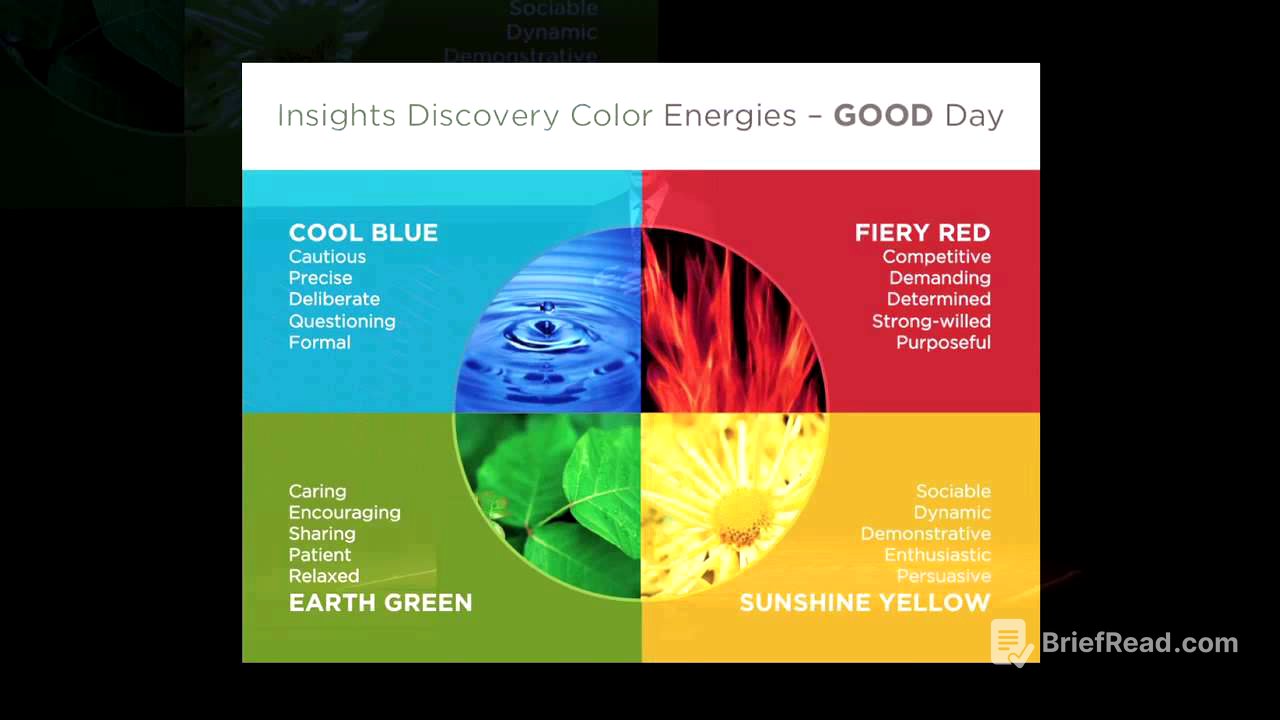TLDR;
This TEDx talk explores the brain science of communication and self-awareness, emphasizing how understanding your personality and others' can ignite business growth and improve relationships. The speaker introduces a model categorizing personalities into fiery red, sunshine yellow, earth green, and cool blue, highlighting the strengths and potential overuses of each. The core message is to use conscious awareness to recognize and adapt to different communication styles, fostering better connections and minimizing misunderstandings.
- Self-awareness is key to effective communication and business growth.
- Understanding different personality types can improve interactions.
- Consciously adapting to others' communication styles fosters better relationships.
Introduction: Igniting Your Business Through Self-Awareness [0:14]
The talk centers on the brain science of communication and its relevance to igniting business growth. It emphasizes the importance of self-awareness and understanding others, highlighting that knowing oneself and others is crucial for effective communication. The speaker poses the question of what it takes to ignite a business, suggesting that the answer lies in the science of communication and, more fundamentally, self-awareness.
The Alliterative Adjective Exercise: Becoming Consciously Aware [0:47]
The speaker engages the audience in an exercise, asking them to describe themselves using an alliterative adjective. This exercise is designed to activate the conscious brain, prompting individuals to think differently about themselves. It underscores the importance of self-perception and how one's self-image aligns with how others perceive them.
The Kitten and the Lion: Understanding Self-Perception [2:24]
The speaker uses the analogy of a kitten seeing a lion in the mirror to illustrate the gap between self-perception and reality. This highlights the importance of understanding how one truly shows up and interacts with others. The speaker touches on the subconscious brain's role in communication, noting how it often makes incorrect assumptions. The speaker emphasizes the need to consciously challenge these patterns to change outcomes and foster new thoughts and ideas.
Frameworks for Self-Awareness: Knowing Yourself and Others [5:18]
The discussion shifts to frameworks for understanding oneself and others, referencing historical models and modern tools like personality assessments. The speaker underscores that these models help individuals understand their wiring and communication styles, which in turn influences how they perceive others. The speaker introduces a model categorizing personalities into four types: fiery red, sunshine yellow, earth green, and cool blue.
The Four Personality Types: Red, Yellow, Green, and Blue [6:38]
The speaker describes the characteristics of each personality type: fiery red (determined, competitive), sunshine yellow (energetic, enthusiastic), earth green (amiable, patient), and cool blue (analytical, cautious). The speaker illustrates how these traits manifest in everyday interactions and decision-making. The speaker emphasizes the importance of recognizing these traits in oneself and others to improve communication.
The Overuse of Gifts: Recognizing Negative Perceptions [9:42]
The speaker cautions against overusing the strengths associated with each personality type, which can lead to negative perceptions. For example, overusing fiery red can be seen as aggressive, while overusing earth green can be seen as docile. The speaker notes that individuals with opposite personality types may perceive these overuses more acutely.
Family Dynamics: Applying the Model at Home [11:59]
The speaker shares personal anecdotes about their family to illustrate how these personality types play out in real-life relationships. The speaker encourages the audience to consider their family members' dominant energies and to interact with them in ways that align with those energies. The speaker touches on the underlying psychology of these models, referencing Jungian psychology and tools like Myers-Briggs.
Practical Application: Awareness in Everyday Interactions [13:14]
The speaker encourages the audience to be aware of these personality traits in everyday interactions, particularly at lunch after the talk. The speaker highlights how certain behaviors can be irritating and are often linked to opposite personality types. The speaker emphasizes that understanding these dynamics can lead to greater self-awareness and improved relationships.
Conclusion: Taking Action and Making a Difference [14:25]
In conclusion, the speaker urges the audience to pay attention, be aware, and use their conscious brain to understand others. The speaker reiterates the importance of knowing oneself and recognizing the uniqueness of others. The speaker encourages the audience to communicate with others in their preferred style, take action, and make a difference by applying these principles.









